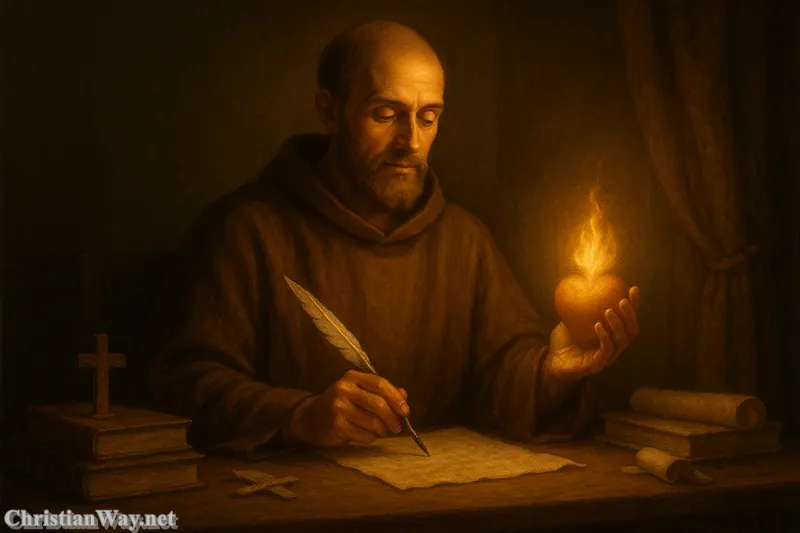Every age of the Church has known men and women who walked so deeply in prayer that heaven seemed to dwell within them. These mystic saints, often hidden from the eyes of the world, became radiant signs of God’s presence — souls who lived in constant communion with the divine mystery. They remind us that prayer is not only words spoken to God, but the very breath of love between Creator and creature.

In this reflection, we will look upon the lives of saints known for their profound prayer and mysticism — those whose contemplation and spiritual experiences opened new windows into the infinite beauty of God. Their lives were not escapes from the world, but luminous paths that invite us to discover how silence, love, and union with God transform every heart that truly seeks Him.
The Call to Mystical Prayer
Before naming these holy souls, we must understand what “mysticism” means in Christian life. Mysticism is not about visions or extraordinary phenomena; it is the deep, living experience of God’s indwelling presence. The mystic is one who no longer prays about God but with God — who listens in the silence of love until only His voice remains.
As Saint Teresa of Ávila said:
“Prayer, in my opinion, is nothing else than a close sharing between friends; it means taking time frequently to be alone with Him who we know loves us.”
Such friendship with God transforms the soul. It is not achieved by effort alone, but by surrender — by allowing grace to lead us into the heart of Christ. The saints of prayer and mysticism teach us this sacred surrender.
1. Saint Teresa of Ávila — The Doctor of Prayer
The Interior Castle and the soul’s journey to God
Saint Teresa of Ávila (1515–1582), the Carmelite reformer, is one of the greatest mystics in Christian history. In her masterpiece The Interior Castle, she describes the soul as a vast crystal castle with many rooms — each representing a stage of spiritual growth, until one reaches the center where God Himself dwells.
Her prayer was deeply contemplative, marked by an intimate love for Jesus and a fearless trust in divine mercy. Though she experienced mystical ecstasies and visions, Teresa never sought them; she only sought to love. Her reform of the Carmelite Order was rooted in returning to simplicity, silence, and love of God in all things.
Her life reminds us that contemplation is not escape but mission — the fruit of union with God is always love for others.
2. Saint John of the Cross — The Mystic of the Dark Night
Union through the darkness of faith
A spiritual companion of Saint Teresa, Saint John of the Cross (1542–1591) gave the Church some of the most sublime mystical poetry ever written. His works, The Dark Night of the Soul and The Ascent of Mount Carmel, explore the soul’s purification and ascent to God through faith alone.
John’s mystical insight reveals that the deepest union with God often happens in darkness — when all images, consolations, and even spiritual sweetness fade away, leaving only love.
He writes:
“To come to the knowledge you have not, you must go by a way in which you know not.”
His teaching is a guide for those who struggle in the silence of prayer, showing that God’s apparent absence is often the very sign of His most intimate work.
3. Saint Francis of Assisi — The Lover of God in All Creation
Mysticism of simplicity and joy
Though not a scholar or theologian, Saint Francis (1181–1226) was a mystic of the heart — one who saw God in the wind, the sun, and every living creature. His prayer was spontaneous, tender, and overflowing with joy.
Francis’s mystical union with Christ reached its peak when he received the stigmata, the wounds of Christ, on Mount La Verna. Yet his true mysticism was not in visions but in his complete poverty of spirit — his ability to love with pure simplicity.
He teaches us that true prayer opens the eyes of the heart to see God everywhere, even in the smallest of His creatures.
4. Saint Catherine of Siena — The Fire of Divine Love
Dialogue with the Eternal Father
This 14th-century Dominican tertiary (1347–1380) was one of the most powerful mystics and reformers of her time. Though she never learned to read or write fluently, her dictations in The Dialogue reveal deep theological insight and an intimate relationship with God.
Catherine experienced mystical visions and the invisible stigmata. Her prayer was consumed by the desire for souls — she offered herself completely for the salvation of others.
In one of her dialogues, God says to her:
“I am He who is; you are she who is not.”
Her mystical humility led her to become a peacemaker, guiding popes and calling the Church to holiness. In her, contemplation and action were one — she prayed as she lived, and lived as she prayed.
5. Saint Thérèse of Lisieux — The Little Flower of Love
The mysticism of the everyday
Saint Thérèse (1873–1897), though she lived a short and hidden life in a Carmelite convent, became one of the Church’s most beloved mystics. Her “Little Way” was not marked by visions or ecstasies, but by trust and love in the smallest moments of life.
She wrote:
“I will seek out a means of getting to Heaven by a little way — very short and very straight, a little way that is wholly new.”
Her prayer was the constant offering of her heart — a mysticism of simplicity that revealed the greatness of ordinary love.
Thérèse shows us that contemplation is not reserved for the few, but open to every soul who loves Jesus with childlike trust.
6. Saint Padre Pio — The Wounded Priest of Compassion
A mystic of suffering and intercession
Saint Pio of Pietrelcina (1887–1968) bore the stigmata for over fifty years. But his mystical life was not about the miraculous alone — it was his deep union with Christ’s suffering that made him a man of extraordinary compassion.
He spent hours in prayer and confessions, guiding souls toward reconciliation with God. Padre Pio’s mystical gifts — bilocation, reading of hearts, and visions — were expressions of his total surrender to divine will.
He reminds us that mystical prayer is not self-centered spirituality, but a call to intercede for the world. To pray is to share the wounds of Christ for the healing of others.
7. Saint Hildegard of Bingen — The Visionary of Divine Harmony
Mysticism expressed through art, music, and creation
Saint Hildegard (1098–1179) was a Benedictine abbess, writer, composer, and mystic who received vivid visions of divine light. Her writings, such as Scivias (“Know the Ways”), blend theology, music, and poetry, revealing the unity of creation in God’s wisdom.
She described her visions not as personal privilege but as a mission to proclaim the harmony between heaven and earth. For Hildegard, prayer opened the human spirit to participate in the divine symphony of creation — a foretaste of the heavenly song of love.
She stands as a witness that mystical contemplation can inspire creativity, science, and art when rooted in faith.
8. Saint Teresa of the Child Jesus and Saint Elizabeth of the Trinity
Contemplation within Carmel
Following the Carmelite tradition, Saint Elizabeth of the Trinity (1880–1906) carried forward the mystical vision of union with God dwelling in the soul. Her simple yet profound spirituality centered on the indwelling of the Holy Trinity.
In her writings, she often prayed:
“O my God, Trinity whom I adore… grant my soul peace; make it Your heaven, Your cherished dwelling place.”
Like Thérèse, she revealed that contemplation is not escape but intimacy — a love so deep it becomes silence before the mystery of God.
9. Saint Bernard of Clairvaux — The Mystic of Love Divine
The soul’s journey through love to God
Saint Bernard (1090–1153), the great Cistercian abbot, was both theologian and mystic. His writings on the Song of Songs express the passionate love between the soul and God as the deepest truth of faith.
He taught that knowledge of God grows not from intellect but from love:
“You will find more in the woods than in books. Trees and stones will teach you what you cannot learn from masters.”
Bernard’s prayer was filled with affection for Christ Crucified. His mysticism was rooted in humility, leading him to reform monastic life and strengthen the Church while remaining a contemplative soul.
10. Saint Mechtilde and Saint Gertrude the Great — Mystics of the Sacred Heart
Visions of divine mercy and intimacy
In the 13th century, these two Benedictine nuns of Helfta experienced profound mystical revelations centered on the Heart of Jesus. Saint Gertrude the Great (1256–1302), especially, was granted visions of Christ’s tender love for humanity. Her Revelations portray prayer as a dialogue of affection between the soul and her Beloved.
Their mysticism became the seed for later devotion to the Sacred Heart, showing that true prayer always draws us into the burning love of Christ — a love that heals and sanctifies.
Mystical Prayer in the Modern World
It might seem that mysticism belongs to another time — to cloisters and saints who lived far from our busy, digital age. But the truth is that the mystic path begins where every Christian stands: in the silence of the heart.
Mysticism is not about withdrawing from the world, but about seeing the world in God. It means cultivating interior stillness in which love can speak. When we pray with sincerity, forgive with mercy, and adore with faith, we begin to live the same mystery that filled the hearts of the saints.
As the Catechism of the Catholic Church teaches:
“Prayer is the life of the new heart. It ought to animate us at every moment.” (CCC 2697)
The mystic saints remind us that prayer is not a duty but a relationship — not performance, but presence.
Learning from the Saints of Prayer
From Teresa’s castles of the soul to Thérèse’s little way, from Francis’s joyful poverty to Catherine’s fiery charity — each saint shows a unique facet of divine intimacy. Yet all share the same center: Christ.
Their contemplation led to mission, their silence gave birth to words of mercy, and their solitude blossomed into love for the whole Church.
Mysticism, then, is not an escape from the world but a transformation of it — through the eyes of faith, everything becomes an encounter with the living God.
Reflect and Pray
Dear friend, perhaps you do not feel like a mystic. Perhaps your prayer feels dry, distracted, or small. But remember: the saints of prayer began where you are — with longing hearts and trembling faith.
Open your heart to God in simplicity. Sit quietly, breathe His name, and listen. The same Spirit who led Teresa, John, Francis, and Thérèse will also guide you. For the heart of prayer is not extraordinary experience, but love.
“Be still, and know that I am God.” — Psalm 46:10
May these saints of prayer and mysticism inspire you to find the sacred silence within, where God dwells and whispers your name in love.
— Fr. John Matthew, for Christian Way











